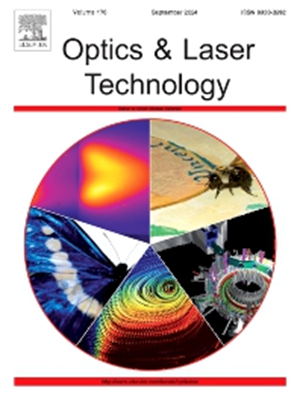Multi-dimensional tool wear detection using Non-Subsampled Shearlet Transform and enhanced pulse coupled neural network in optical microscopy reconstruction
IF 4.6
2区 物理与天体物理
Q1 OPTICS
引用次数: 0
Abstract
The milling tool plays a pivotal role in the fabrication of components within the aerospace and various other industrial sectors. Consequently, it is essential to perform swift, accurate, and comprehensive evaluations of tool wear throughout the manufacturing and processing stages. Traditional methods for assessing tool wear often suffer from limitations due to their dependence on singular evaluation criteria and a lack of detailed wear information. To overcome these challenges, this study introduces a multi-dimensional tool wear detection system utilizing optical microscopy vision to capture fully-focused images of the tool and reconstruct the shape of the wear region, which is designed to enable efficient, high-precision, and holistic evaluation of wear parameters. Furthermore, Non-Subsampled Shearlet Transform (NSST) and an enhanced pulse coupled neural network (PCNN)are used to extract 3D depth information, which facilitate the creation of a high-precision tool depth map by mapping high-frequency subbands to different depth levels while simultaneously obtaining the fully-focused image. Additionally, an inspection criterion is established that encompasses a multi-dimensional evaluation of wear metrics, including wear value, area, and volume. Compared to standard equipment, the error of wear value was found to be less than 0.005 mm, and the error rate of area, and volume was less than 2.5 %. Experimental results demonstrate that the proposed method offers more comprehensive assessment metrics for evaluating tool wear. It can be used to offer valuable feedback of tool state for machining processes.
求助全文
约1分钟内获得全文
求助全文
来源期刊
CiteScore
8.50
自引率
10.00%
发文量
1060
审稿时长
3.4 months
期刊介绍:
Optics & Laser Technology aims to provide a vehicle for the publication of a broad range of high quality research and review papers in those fields of scientific and engineering research appertaining to the development and application of the technology of optics and lasers. Papers describing original work in these areas are submitted to rigorous refereeing prior to acceptance for publication.
The scope of Optics & Laser Technology encompasses, but is not restricted to, the following areas:
•development in all types of lasers
•developments in optoelectronic devices and photonics
•developments in new photonics and optical concepts
•developments in conventional optics, optical instruments and components
•techniques of optical metrology, including interferometry and optical fibre sensors
•LIDAR and other non-contact optical measurement techniques, including optical methods in heat and fluid flow
•applications of lasers to materials processing, optical NDT display (including holography) and optical communication
•research and development in the field of laser safety including studies of hazards resulting from the applications of lasers (laser safety, hazards of laser fume)
•developments in optical computing and optical information processing
•developments in new optical materials
•developments in new optical characterization methods and techniques
•developments in quantum optics
•developments in light assisted micro and nanofabrication methods and techniques
•developments in nanophotonics and biophotonics
•developments in imaging processing and systems

 求助内容:
求助内容: 应助结果提醒方式:
应助结果提醒方式:


